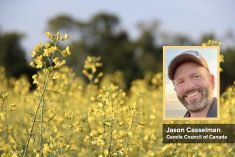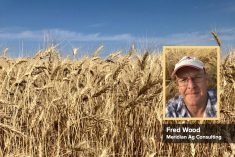Glyphosate is a world of contrasts. For growers, it’s the most widely used herbicide, certainly in North America and possibly the world. It is safe, effective, has been cost-efficient for more than 20 years and is known as “a one-in-100-year molecule” that has revolutionized modern agriculture.
Glyphosate’s safety and long-term efficacy has been the subject of hundreds of studies during its history, with federal and trade agencies affirming their support for its continued use.
For activists, glyphosate has been charged with everything from residues in watercourses and soil to traces in processed foods and beverages. It has been the subject of legal action, protests, and an organized movement to ban its use outright. Although activists have cited their own body of health and environmental studies, the veracity of those studies has been challenged and their results repeatedly questioned by the world’s scientific community.
Read Also

Agronomists share tips for evaluating new crop products and tech: Pt. 3
With new products, new production practices and new technology converging on the agriculture industry at a frenetic pace in recent…
Despite the best available science upholding research about its safety and efficacy, there is concern today within Canada’s agri-food industry about glyphosate’s outlook. According to one industry representative, all major edible bean buyers in Canada stated in 2018 that they would no longer accept edible beans sprayed with a pre-harvest glyphosate application for desiccation. The problem with that statement is that glyphosate is not registered as a desiccant. Even then, there are guidelines governing its usage in that window, with moisture levels that must be less than 30 per cent for cereals, pulses and canola. Levels that are above 30 per cent could cause glyphosate traces to be absorbed by the plant, leaving residues on the harvested crop.
The herbicide’s usage has sparked intense consumer debate, which has prompted government restrictions on its use as a “cosmetic” herbicide in eight of 10 provinces in Canada. Declarations by consumer groups that minute amounts of glyphosate have been detected in breakfast cereals, orange juice and wine have renewed calls for a ban on its use in agricultural applications. And there is the landmark case in the U.S. that is under appeal of its initial findings — that glyphosate was the cause of cancer in a groundskeeper — even though scientific research has concluded that glyphosate is not a carcinogen.
This is the backdrop that concerns Pierre Petelle. In spite of court proceedings, media coverage and the European Union’s implementation of non-tariff barriers on agricultural products, he’s optimistic that glyphosate will remain viable. He bases that perspective on reviews of all available literature and scientific data by regulators from around the world, including Europe, the United States and Canada.
“They’ve all come to the exact same conclusion: this is not a carcinogen and the use of this product will not increase a person’s risk of cancer,” says Petelle, president and chief executive officer of CropLife Canada. “To me, from a scientific perspective, the toxicology question, the risk of carcinogenicity, all have been put to bed.”
What continues to confound the issue are the findings of the International Agency for Research on Cancer (IARC), a division of the Worth Health Organization (WHO). In 2015, the IARC proclaimed that glyphosate “is probably carcinogenic” to humans, a statement which drew criticism from scientists around the world because it ignores the facts surrounding glyphosate and its use.
A muddied picture
Yet for every step in the wrong direction with glyphosate, there seems to be one step forward. The court case in California, which originally awarded $289 million to a groundskeeper claiming he’d contracted cancer from exposure to glyphosate, rejected attempts to introduce science-based information to the proceedings. That was in August 2018 and the verdict has been appealed since then with considerable decreases in the award. This past August, the Environmental Protection Agency (EPA) ruled that the State of California cannot label Roundup as a carcinogen, determining that the California law contravened federal law, spurring the ruling by the EPA.

Generally in Canada and other jurisdictions, courts rarely get into questions of scientific findings. But in the U.S., there are few qualms about weighing in on cause-and-effect relationships on very scientific questions and making decisions on the use of chemistries or compounds.
“It makes no scientific sense and that’s why we’re seeing these outrageous findings with awards in the multi-millions of dollars,” says Petelle. “Now, they’re all under appeal and Bayer is confident that justice and science will prevail, but in the meantime, it’s a steady stream of negative media coverage.”
In spite of the pessimism outside of agriculture, Petelle is confident that agencies such as Health Canada will continue to uphold the science surrounding glyphosate and its usage. Within the industry, he points to the “Keep it Clean” campaign in Western Canada as an example of how commodity organizations — with support of CropLife Canada — are working to ensure the free flow of trade and “export ready” production. Petelle cites an Italian pasta maker’s rejection of Canadian durum because of glyphosate residues as one concern. As an example, “Keep it Clean” urges growers to monitor moisture levels and use pre-harvest glyphosate only when seed moisture is less than 30 per cent.
“Rather than talking about banning a compound or eliminating its use, the commodity groups and our industry would rather focus their energy with growers on the proper timing,” says Petelle. “That way we don’t have a problem with applications too close to harvest or that are done at the wrong time and cause unnecessary residues in the crop. That can create more of the angst that’s out there in the public forum.”
Now the big question: Why?
Behind the fight to maintain glyphosate, there’s a broader perspective that has to be considered: Is glyphosate just the first battle front? Are there other agricultural products being targeted?
Trish Jordan agrees that glyphosate may be the “easy target.” She notes that Canada’s Pest Management Regulatory Agency (PRMA) offered a strong defense for glyphosate’s re-evaluation, as did the U.S. EPA and the European Food Safety Authority (EFSA). But the activists are targeting glyphosate for a reason she says, and it’s because it’s the most benign yet most widely used weed management product in the world.
“If it’s banned or removed from production agriculture, what are the grounds for any other chemical product to be maintained?” asks Jordan, public and industry affairs director with Bayer Canada. “It’s not a question of this product being safe; these things become quite political.”

Jordan is also quick to reiterate that glyphosate is not registered for use as a desiccant. But that’s also treated as an opportunity to solidify communications between the company and growers. She’s also a proponent of “Keep it Clean” and its focus on farm management practices and input products to ensure that exports can move freely to countries without issue.
“That’s the industry’s answer, that’s the commodity groups’ answer and that’s our answer,” says Jordan. “We’ve increased our communication around a pre-harvest application. If you follow the label — the right rate, the right time and the right reason — there’s no issue.”
At the same time, Bayer doesn’t advocate growing a single crop in successive years and relying on one chemistry. That is not a sustainable production system and most companies, retailers and consultants agree.
“We spend a lot of time trying to provide the proper context because the presence at the levels that are being found are within allowable established maximum residue levels (MRLs)”, says Jordan. She adds that MRLs are a trade component, not a food safety factor. “But there are folks on the other side whose whole mandate is to try to create uncertainty and have people worried about these things. They have a different agenda where they don’t want any chemistry used anywhere in modern agriculture, which is not realistic.”
Broader perspective
In spite of all of the communications initiatives and strengthening of science-based stances, there’s a risk of loss, not just of glyphosate but for all chemical products, as Jordan states. Yet in behind the foreground discussions is the question of whether the agri-food industry and the food value chain are listening to the concerns of consumers. Yes, the “Keep it Clean” campaign is generating worthwhile conversations and opportunities for learning. But is that enough?
That’s the concern of Wayne Black, who acknowledges that some growers are misusing some products and that it’s time the industry as a whole began listening to concerns about herbicide residues.
“If we don’t change how we handle and manage any product, be it glyphosate or anything from the farm, there is a risk that we could lose access to that product,” says Black, agronomy sales manager with Sunderland Co-op.
“Today glyphosate is the lightning rod but tomorrow it could be another important tool. I don’t know how large you need to build the billboard for farmers and the industry to say that.”
An example Black cites is a consumer who says they’ll stop buying a breakfast cereal because it has glyphosate in it. Industry stakeholders and scientists can counter that coffee is more toxic than the cereal they’re eating. But that’s not the answer agriculture should be giving, even if it’s true, simply because it’s the person’s 10-month-old child that’s eating the cereal, not drinking coffee.
At that point, it’s not about “detection does not equal toxicity.” It’s asking the industry whether everything is being done to help soothe the concerns of consumers. General Mills, for instance, recently launched its new food safety and ecosystem health initiative in August 2019, with a pledge to be more sustainable in its food production practices by 2030.
Again, the ultimate question seems to be: How large a billboard does it take to convey the message that changes are needed?
A letter to the WTO
Last July, a letter was sent to the World Trade Organization concerning the European Union’s implementation of non-tariff barriers on agricultural products. According to Pierre Petelle, president and chief executive officer of CropLife Canada, it was an unprecedented move by 16 countries to demand action against the EU as it erects trade barriers contrary to previous agreements.
Petelle notes the EU’s rejection of sound science is going to have an impact on any country that exports to countries in the Union. It’s treading a path that removes tools from their own growers for political reasons, and they seem to be intent on removing the import tolerances — the maximum residue levels (MRLs) for those commodities.
“From our perspective, we go through a rigorous scientific system here, where we get approvals, we get MRLs approved here, we get MRLs approved in Europe and trade is enabled,” explains Petelle. “If Europe starts to remove those residue tolerances, that’s going to have a tremendous impact on exporters. The signatories to the WTO are supposed to have a risk-based approach to enable trade on residues and our hope is that they’ll be held accountable to that.”
In addition to Canada and the U.S., Australia, Brazil, Colombia, Costa Rica, Dominican Republic, Ecuador, Guatemala, Honduras, Malaysia, Nicaragua, Panama, Paraguay, Peru and Uruguay were also involved.
Further reading
















